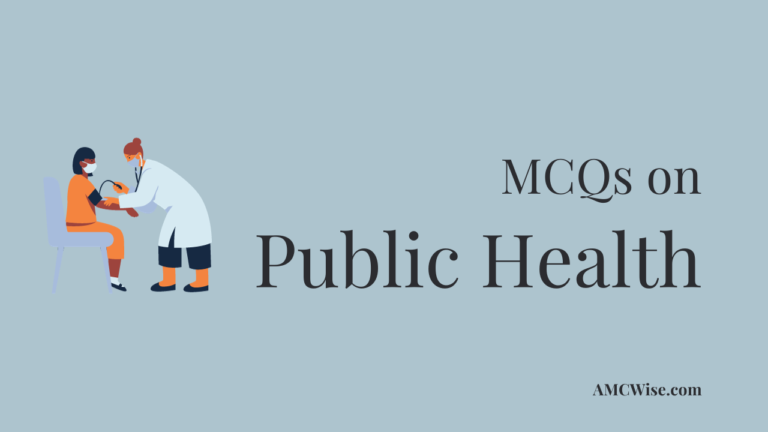Psychiatry MCQs for AMC Part 1 Exam

Understanding psychiatry disorders is a crucial component of medical knowledge, and it’s indispensable for success in the AMC Part 1 CAT MCQ exam. Whether you’re a dedicated medical student or a healthcare professional gearing up to tackle the challenges of this comprehensive exam, we present to you a thoughtfully curated collection of multiple-choice questions (MCQs) centered around psychiatry disorders.
Our objective is to provide you with a comprehensive and efficient study resource, meticulously designed to evaluate and enhance your diagnostic skills across a spectrum of psychiatric conditions.
Question 5001
A 45-year-old man frequently visits his primary care physician, reporting various physical symptoms and expressing intense anxiety about his health. He has visited the clinic multiple times in the past six months, complaining of chest pain, headaches, abdominal discomfort, and numbness in his extremities. Extensive medical evaluations, including physical examinations and diagnostic tests, consistently reveal no underlying medical conditions. Despite reassurance from multiple healthcare providers that he is physically healthy, the patient remains preoccupied with the belief that he has a severe, undiagnosed illness. What is the most likely diagnosis for this patient’s condition?
- A) Somatic symptom disorder
- B) Generalized anxiety disorder
- C) Panic disorder
- D) Hypochondriasis
- E) Obsessive-compulsive disorder
Question 5002
A 34-year-old woman presents to the emergency department with a history of recurrent, dramatic, and seemingly life-threatening medical conditions. She has been hospitalized numerous times over the past year for various ailments, including gastrointestinal bleeding, seizures, and respiratory distress. However, her medical workup consistently fails to reveal any organic pathology. The patient appears calm and cooperative throughout her hospitalizations and often engages in conversations with healthcare providers about her medical history, which seems inconsistent and improbable. She frequently seeks out medical attention, even going to different hospitals, and has an extensive list of surgeries and procedures in her medical records. What is the most likely diagnosis for this patient’s behavior?
- A) Munchausen syndrome by proxy
- B) Hypochondriasis
- C) Factitious disorder imposed on self (Munchausen syndrome)
- D) Somatic symptom disorder
- E) Conversion disorder
Question 5003
A 45-year-old woman has been experiencing persistent low mood, loss of interest in previously enjoyed activities, fatigue, feelings of worthlessness, and difficulty concentrating for the past six months. She has also had changes in appetite and sleep patterns, with significant weight loss. Which of the following is the most likely diagnosis?
- A) Major depressive disorder (MDD)
- B) Generalized anxiety disorder (GAD)
- C) Bipolar disorder
- D) Schizophrenia
- E) Post-traumatic stress disorder (PTSD)
Question 5004
A 30-year-old individual has a history of unstable and intense interpersonal relationships. They frequently exhibit impulsive behaviors such as reckless driving and substance abuse. This individual has a chronic fear of abandonment and often engages in self-harming behaviors, such as cutting, when they feel overwhelmed. They frequently experience intense mood swings and have a poor sense of self-identity. What is the most likely diagnosis for this individual?
- A) Histrionic Personality Disorder
- B) Antisocial Personality Disorder
- C) Narcissistic Personality Disorder
- D) Borderline Personality Disorder
- E) Avoidant Personality Disorder
Question 5005
A 25-year-old individual has been experiencing auditory hallucinations, delusions, disorganized thinking, and social withdrawal for the past several months. They believe that they have special powers and that they are being followed by government agents. The individual’s speech is often incoherent, and they have difficulty maintaining conversations. What is the most likely diagnosis for this individual?
- A) Bipolar Disorder
- B) Schizophrenia
- C) Dissociative Identity Disorder
- D) Generalized Anxiety Disorder
- E) Major Depressive Disorder
Question 5006
A 28-year-old male presents to a mental health clinic with a complaint of excessive fear and anxiety in social situations. He reports feeling intensely self-conscious, worrying about being embarrassed, and avoiding social events whenever possible. This has significantly impaired his ability to maintain relationships and participate in work-related activities. Which of the following is the most likely diagnosis?
- A) Major depressive disorder
- B) Social phobia
- C) Panic disorder
- D) Generalized anxiety disorder
- E) Bipolar disorder
Question 5007
A 35-year-old combat veteran seeks psychiatric evaluation due to distressing symptoms following a traumatic event experienced during military service. He reports recurrent nightmares, flashbacks, and intense distress when exposed to reminders of the traumatic event. He also mentions hypervigilance, exaggerated startle response, and avoidance of situations that trigger memories of the trauma. What is the most likely diagnosis?
- A) Major depressive disorder
- B) Generalized anxiety disorder
- C) Post-traumatic stress disorder (PTSD)
- D) Panic disorder
- E) Obsessive-compulsive disorder (OCD)
Question 5008
A 19-year-old female presents to her healthcare provider with a history of restricted food intake, intense fear of gaining weight, and a distorted body image. She has experienced significant weight loss and amenorrhea. Physical examination reveals emaciation, lanugo hair, and brittle nails. She acknowledges that she is underweight but insists on continuing her restrictive eating behaviors. Which of the following is the most likely diagnosis?
- A) Bulimia nervosa
- B) Binge-eating disorder
- C) Avoidant/restrictive food intake disorder (ARFID)
- D) Orthorexia nervosa
- E) Anorexia nervosa
Question 5009
A 28-year-old individual frequently seeks attention and is often described as dramatic and excessively emotional. They often wear provocative clothing and engage in seductive behavior to draw attention. This individual’s emotions seem shallow, and their relationships are often characterized by being fleeting and superficial. They tend to be easily influenced by others and are often perceived as insincere. What is the most likely diagnosis for this individual?
- A) Histrionic Personality Disorder
- B) Borderline Personality Disorder
- C) Narcissistic Personality Disorder
- D) Antisocial Personality Disorder
- E) Dependent Personality Disorder
Question 5010
A 27-year-old individual presents with a sudden onset of elevated mood, increased energy, decreased need for sleep, and racing thoughts. During this period, they engage in risky behaviors such as excessive spending, reckless driving, and promiscuous sexual activity. They also report feeling extremely irritable and have difficulty concentrating. What is the most likely diagnosis?
- A) Major depressive disorder
- B) Generalized anxiety disorder
- C) Attention-deficit/hyperactivity disorder (ADHD)
- D) Schizophrenia
- E) Bipolar mania
References
- https://www.psychdb.com/somatic/dsm-iv/hypochondriasis
- https://www.betterhealth.vic.gov.au/health/conditionsandtreatments/munchausen-syndrome
- https://www.ncbi.nlm.nih.gov/books/NBK207191/box/part1_ch3.box19/?report=objectonly





